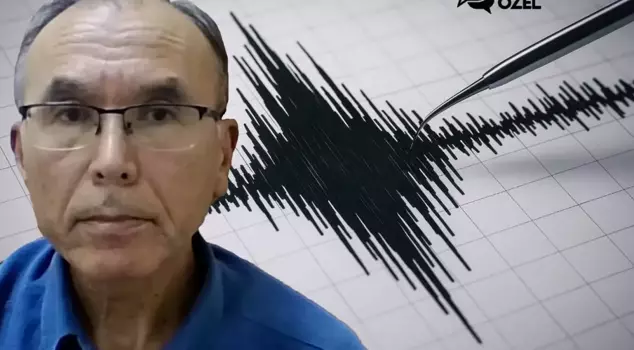
02.10.2025 19:42
Evaluating the 5-magnitude earthquake that occurred in the Marmara Region for Haberler.com, Assoc. Prof. Dr. Bülent Özmen emphasized that the stress on the Kumburgaz segment has not yet been released and that the danger in Marmara is still high. Özmen also noted that aftershocks of magnitude 4 and above may continue, stating that the recent earthquake could be a precursor to a 'major Marmara earthquake.'
```html
Afet Management Expert, Gazi University Faculty Member Assoc. Dr. Bülent Özmen, who spoke to Dilşad Özcan from Haberler.com, evaluated the earthquake of magnitude 5 that occurred in the Marmara Region.
Özmen emphasized that the earthquake on April 23 could be an aftershock, that the stress on the Kumburgaz segment has not yet been released, and that the earthquake risk in Marmara is still quite high. He also stated that aftershocks of magnitude 4 and above could continue, suggesting that the recent earthquake could be a precursor to the Great Marmara Earthquake.
Özmen's evaluations are as follows:
"WE PREDICT THAT THIS EARTHQUAKE COULD BE AN AFTERSHOCK OF THE EARTHQUAKE ON APRIL 23"
"According to the announced data, we experienced a 5 magnitude earthquake near the exact intersection point of the Tekirdağ segment, referred to as the Marmara depression, and the Kumburgaz segment, approximately 18 kilometers south of Marmaraereğlisi. If you recall, on April 23, 2025, there was also a 6.2 magnitude earthquake near this point, slightly to the west, on the Kumburgaz segment. There were numerous aftershocks following the earthquake on April 23. We predict that this 5 magnitude earthquake could be related to that earthquake and could be one of its aftershocks. Of course, since the earthquake is still fresh, as the aftershocks become more frequent, we may have a better chance to discuss the earthquake more accurately.
"STRESS ON THE KUMBURGAZ SEGMENT HAS NOT YET BEEN RELEASED AND LARGER EARTHQUAKES MAY OCCUR"
This Tekirdağ segment and the Kumburgaz segment, in fact, the Tekirdağ segment was broken by an earthquake of 7.2 magnitude in 1912. This segment requires quite a long time to produce a larger earthquake. However, the segment referred to as the Kumburgaz segment unfortunately produced two large earthquakes over 7 in May and August, approximately 259 years ago in 1766. Therefore, despite the 6.2 magnitude earthquake that occurred on April 23, 2025, the stress in this region has not been released, and we have demonstrated through many scientific studies that there is a possibility of larger earthquakes occurring along this fault line. Therefore, this is not actually surprising.
"THE EARTHQUAKE RISK IN MARMARA HAS NOT PASSED"
Unfortunately, the Marmara region has the potential to face earthquakes of this magnitude and even larger ones, although we cannot specify the exact timing. I think it is beneficial to interpret the earthquake in this way. Sometimes some scientists say that the earthquake risk in Marmara has passed, and that the largest was 6.2, as in the case of April 23. This actually indicates that the earthquake risk in Marmara has not passed, and we must never forget that this region harbors many faults that are quite high in terms of earthquake risk and are prone to larger earthquakes.
"THERE IS A NEED TO INCREASE STUDIES THAT WILL REDUCE EARTHQUAKE RISK"
We know that there are many existing studies on reducing earthquake risks, but the number, frequency, and quality of these studies need to be rapidly increased so that we can make Istanbul and the Marmara region, and subsequently all of Turkey, resistant to earthquakes. This earthquake reminds us of the importance of focusing more seriously on these studies without wasting any time.
"THE POSSIBILITY OF AFTERSHOCKS OF MAGNITUDE 4 AND ABOVE IS VERY HIGH"
It is necessary to follow the developments. We need to monitor whether the earthquake will continue to decrease in intensity or if a larger one may occur, especially by the relevant authorities such as AFAD, the Ministry of Interior, and the Istanbul Governorship. If we consider this as the main shock, the possibility of aftershocks of magnitude 4 or even slightly above 4 occurring in the following hours or minutes is quite high.
"CITIZENS SHOULD NOT ENTER DAMAGED BUILDINGS"
However, we must not ignore the fact that there is a possibility of a larger earthquake, even if it is low, and we need to determine our roadmap and behavior accordingly. Although buildings of this magnitude are not expected to be damaged, if there are damaged buildings, citizens should definitely not enter these buildings. Those living in other buildings should also determine their roadmaps based entirely on their own preferences.
"THIS EARTHQUAKE IS A PRECURSOR TO THE GREAT MARMARA EARTHQUAKE"
In fact, this should not be thought of as a trigger but rather as a precursor. When we say precursor, we should not think of it as a sign of an earthquake that will happen shortly. This earthquake actually clearly indicates that the earthquake risk in the Marmara region is high, and that the accumulation of stress here has reached a very high level. Although we cannot know the exact timing, we should read this as a reminder that the region is likely to be exposed to larger earthquakes. Right now, neither we nor any scientist can say whether a larger one will come. We can only express this after it occurs. However, when we look at the fault lines in the region, the earthquake data they have produced in the past, the earthquake hazard map, and other studies, we can unfortunately say that the fault lines in the vicinity of where this earthquake occurred have the potential to produce a larger one."
```